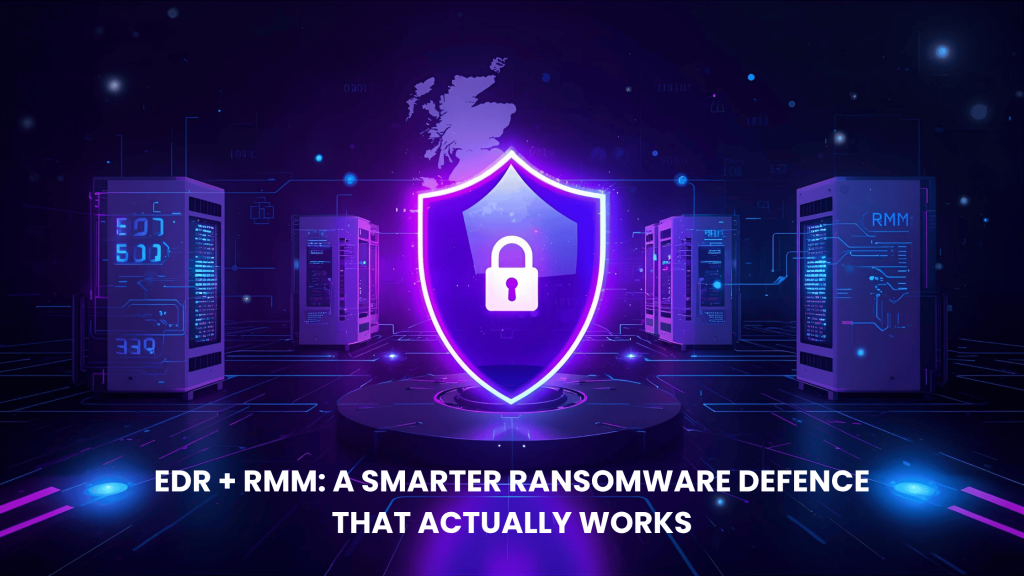EDR + RMM: A Smarter Ransomware Defence That Actually Works
Ransomware isn’t just a tech problem it’s a business problem. It locks you out of your own systems, stalls operations, and puts client trust on the line. Even if you never pay a ransom (you shouldn’t), the downtime alone can cost days of productivity and a lot of stress. The good news: when Endpoint Detection & Response (EDR) and Remote Monitoring & Management (RMM) work together, you get fast detection, strong prevention, and quicker recovery without slowing the team down.
The quick refresher: what ransomware does
Attackers get a foothold (usually via phishing or an unpatched app), move quietly, and then encrypt files and backups. By the time you notice, the damage is done. That’s why real-time detection and solid housekeeping are essential.
How EDR stops ransomware in its tracks
Think of EDR as your on-device security analyst. It watches behaviour, not just signatures, and reacts in real time.
- Spots suspicious activity like mass file changes, malicious scripts, and unauthorised encryption.
- Blocks and contains kills processes, quarantines files, and can isolate a device from the network to stop spread.
- Gives us a clear timeline (who, what, where) so we can respond with confidence and prove what happened.
How RMM keeps the doors locked in the first place
RMM is the quiet workhorse in the background keeping endpoints healthy, compliant, and visible.
- Patching & updates for OS and apps, on schedule.
- Asset inventory & vulnerability checks so we know what’s out there and what needs attention.
- Automation for device baselining, hardening, and remote actions (lock, wipe, deploy tools).
- Health monitoring for backup status, disk space, AV/EDR service health, and more.
Why they’re better together
EDR is your alarm and first responder; RMM is your prevention and clean-up crew. EDR detects and contains an active threat. RMM makes sure endpoints are hardened beforehand, and then helps us react at scale pushing emergency patches, scripts, or even restoring devices after an incident. The result is less noise, faster action, and fewer surprises.
Step-by-step: integrating EDR and RMM for maximum protection
Step 1: Map your environment
We start with a simple inventory: which devices you have, who uses them, and what’s business critical. From there we group endpoints (finance, leadership, frontline, servers) so policies can be tighter where risk is higher.
Step 2: Baseline and harden with RMM
We apply a standard build: OS fully patched, unsupported apps removed, local admin rights restricted, disk encryption enabled, secure configurations applied. Backups are checked and scheduled. This gives EDR a clean, consistent platform to protect.
Step 3: Roll out EDR (quietly and quickly)
Using RMM, we deploy the EDR agent to all in-scope devices without interrupting users. Policies start in “report then block” for a short pilot so we can tune any edge cases. After that, we move to full protection (block mode) with device isolation enabled.
Step 4: Connect signals and alerts
Alerts from EDR feed into our monitoring so nothing gets missed. We keep alerting meaningful priority for true ransomware behaviours (encryption patterns, privilege escalation, suspicious PowerShell). RMM continues to watch patch status, backup health, and EDR service health.
Step 5: Automate the first 15 minutes
Speed matters. We pre-build actions so the response is immediate:
- EDR auto-isolates the device and kills the process when ransomware behaviour is confirmed.
- RMM pushes a “containment script” fleet-wide (e.g., disable SMBv1 where required, rotate local credentials, block known bad hashes, tighten firewall rules).
- Backups are verified so recovery can start if needed.
Step 6: Protect your data paths
We apply least-privilege access and restrict lateral movement. Simple wins include removing stale admin accounts, enforcing MFA everywhere, and tightening share permissions. For remote users, we block risky legacy protocols and enforce secure DNS/traffic rules.
Step 7: Test restores and rehearse
Backups only matter if they restore. We test a representative set of restores quarterly and keep a short runbook so anyone on duty can follow it. We also run a tabletop exercise to rehearse the playbook who calls whom, what gets isolated, and how we communicate with staff and clients.
Step 8: Keep it current
Ransomware changes tactics. We review monthly: patch compliance, EDR detections, false positives, vulnerability trends, and any policy gaps. Small, regular tweaks beat big, disruptive overhauls.
What this feels like for your team
Most of this is invisible to staff. Devices are up-to-date, access is sensible, and if something suspicious happens, containment is swift and targeted. We focus on keeping people productive while quietly reducing risk in the background.
What we handle for you
We design the policies, deploy the tooling, and run the day-to-day monitoring so you don’t have to. That includes onboarding new devices, handling alerts, tuning policies, testing restores, and reporting back in plain English what happened, what we did, and what’s next.
The takeaway
Ransomware defence isn’t one product it’s a partnership between EDR and RMM, backed by a clear playbook and regular housekeeping. Put them together and you get a stronger, faster, more reliable way to protect your business.




